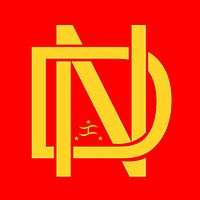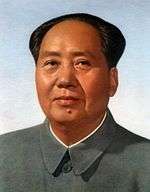National Democracy Movement (Philippines)
| National Democracy Movement of the Philippines | |
|---|---|
 | |
| Active region(s) | Philippines, United States, Canada, Netherlands, Australia |
| Ideology |
Anti-Imperialism, Communism, Left-wing nationalism, Progressivism, Socialism, Maoism |
The National Democracy movement (also called the National Democratic or ND movement) is a broad-based alliance of left-leaning progressive individuals and organizations seeking comprehensive social, economic, and political justice in the Philippines composed of landless peasants, urban and rural poor, indigenous peoples, oppressed religious minorities, activists, workers, youth, and students.[1][2] The movement seeks to address what they consider to be the root causes of injustices affecting the Filipino masses in what is analyzed to be a semi-colonial and semi-feudal society, by confronting the three fundamental problems of imperialism, feudalism, and bureaucrat capitalism.[3]
| Communist parties |
|---|
 |
|
Europe
Former parties |
|
Oceania
Former parties
|
|
Related topics |
| Part of a series on |
| Maoism |
|---|
 |
|
The National Democratic Struggle wishes to achieve genuine 'national liberation' for the country and the realization of the democratic rights of the people[4] by expunging the nation of foreign imperialism, landlordism, monopoly capitalists, and corrupt government officials.
History and background
The National Democratic movement has its origins in against former president Ferdinand Marcos during the late 1960s and early 1970s, but in its entirety is interpreted by the ND as a continuation of struggles since the Philippine Revolution led by the Katipunan. As a result of sustained economic, political, and military abuses during the Marcos dictatorship, several figures such as Jose Maria Sison (writing under the eponym Amado Guerrero) proposed that the creation of a mass revolutionary movement of a national democratic character was necessary to overcome the "three basic problems" underpinning the oppressive conditions of Philippine society in the 1970s. Sison's vision uses Marxist–Leninist–Maoist principles for social analysis and in carrying out people's democracy or national democracy:
Under the present concrete conditions of Philippine society which are semicolonial and semifeudal, the Communist Party has to wage a national democratic revolution of a new type, a people's democratic revolution. Though its leadership is proletarian, the Philippine Revolution is not yet a proletarian-socialist revolution. We should not confuse the national-democratic stage and the socialist stage of the Philippine Revolution. Only after the national-democratic stage has been completed can the proletarian revolutionary leadership carry out the socialist revolution as the transitional stage towards communism.
::— Philippine Society and Revolution p.78 [5]
Once martial law was lifted in 1981 and Corazon Aquino was elected to the Presidency in 1986 after the People Power Revolution, corruption and abuse of government power remained endemic in the Philippine political system, which according to the ND were exemplified by the Mendiola massacre, the counter-insurgency programs waged against the armed groups of the Moro Islamic Liberation Front and the New People's Army, embezzlement and graft during the terms of Joseph Estrada and Gloria Macapagal-Arroyo, and the Hacienda Luisita Massacre (2004). According to the "ND analysis" espoused by Sison and others throughout the 1970s until today, the continuation of human rights violations in the Philippines at the hands of government officials and other social, economic, and political injustices highlight the need of liberating the nation the imperialist forces—primarily led, from what ND proponents identifies, the United States. As a former U.S. colony, the Philippines' dynamic with the United States dates back to the Philippine–American War.
Alliance Organizations
Bagong Alyansang Makabayan (English: New Patriotic Alliance) or BAYAN, Alliance of Concerned Teachers, Anakpawis, Bayan Muna, GABRIELA, and Kabataan Partylist (English: Youth Partylist), to name a few, are among a multitude of organisations that comprise and overlap with the movement. The movement seeks to advance national democracy and freedom from imperialism in the Philippines. The ND movement is interwoven with a larger global alliance: the International League of Peoples' Struggle (ILPS).[6]
A partial list of members:[7][8]
- Alliance of Concerned Scientists, Technologists, Engineers and People (STEP)
- Alliance of Concerned Teachers (ACT)
- AMIHAN (National Federation of Peasant Women)
- Anakbayan (Philippines)
- Anakbayan-USA
- Anakpawis
- Babae-GABRIELA Babae-SF
- Bagong Alyansang Makabayan (BAYAN)
- Bayan Muna
- BAYAN-USA
- Committee for Human Rights in the Philippines (CHRP)
- Ecumenical Movement for Justice and Peace
- Gabriela Women's Party (GABRIELA)
- Health Alliance for Democracy (HEAD)
- Kabataang Makabayan
- Kabataan Partylist
- KARAPATAN: Alliance for the Advancement of People's Rights.
- Kalipunan ng Mga Katutubong Mamamayan ng Pilipinas (KAMP) (National Alliance of Indigenous Peoples Organizations in the Philippines)
- Kalipunan ng Damayang Mahihirap (KDM) (Militant Center of the Filipino Urban Poor)
- Katribu Partylist (Progressive Indigenous Peoples' Party of the Philippines)
- Kilusan ng Manggawang Kababaihan (Pilipina Women Workers' Movement)
- Kilusang Magbubukid ng Pilipinas (KMP) (Peasant Movement of the Philippines)
- Kilusang Mayo Uno (KMU) (May First Movement)
- Kusog sa Katawhang Lumad sa Mindanao (KALUMARAN) (Mindanao Alliance of Indigenous Peoples)
- League of Filipino Students (LFS)
- Makabayang Koalisyon ng Mamamayan (Patriotic Coalition of Citizens)
- MIGRANTE (Alliance of Filipino Migrants Organizations)
- Pambansang Lakas ng Kilusang Mamamalakaya ng Pilipinas (PAMALAKAYA) (National Federation of Fisherfolk Organizations)
- Promotion of Church People's Response (PCPR)
- Samahan ng Malayang Kababaihang Nagkakaisa (SAMAKANA) (Association of United and Free Women)
- Student Christian Movement (Philippines)
References
- ↑ "Youth and Student Movement in the Philippines". Anakbayan-LA. Retrieved 12 October 2012.
- ↑ "Sounds of a New Hope (Trailer)". Sounds of a New Hope. tha illest 59. Retrieved 31 December 2012.
- ↑ Guerrero, Amado (1979). "Philippine Society and Revolution" (PDF). Book. International Association of Filipino Patriots. p. 215. Archived from the original on 2011.
- ↑ "About | Anakbayan". Retrieved 17 October 2012.
- ↑ Guerrero, Amado (1979). "Philippine Society and Revolution". p. 78.
- ↑ "International League of Peoples' Struggle". Retrieved 1 January 2013.
- ↑ "Participating Organizations". Fourth Assembly of the ILPS. International League of Peoples' Struggle. Retrieved 1 January 2013.
- ↑ A fuller list of ND-aligned organizations can be found in the "Philippines" section of the ILPS "Participating Organizations" page.